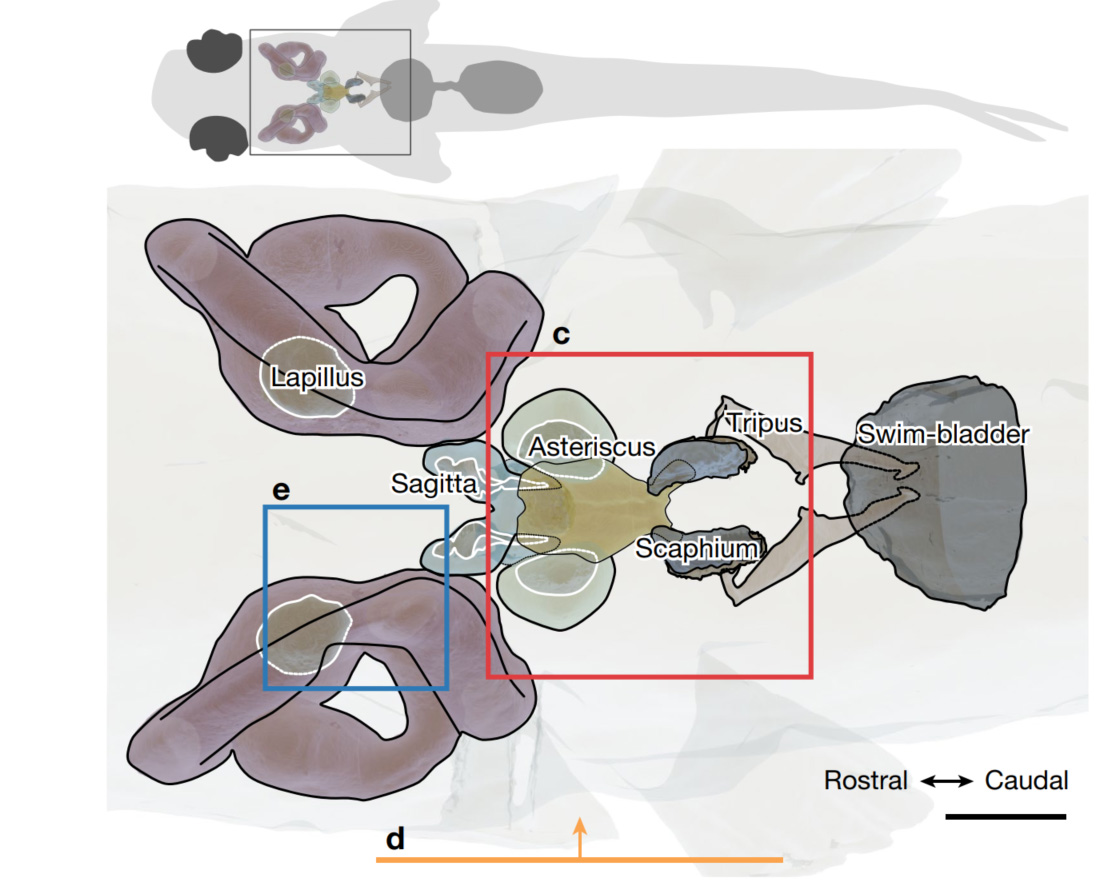The human brain determines the direction of a sound by analyzing the interval between the moment the sound is detected successively by one ear and then the other. On land, this is effective. However, underwater, sounds travel about five times faster than on land, making this method ineffective. This is why we cannot localize sound sources underwater, unlike fish. But how do they manage it?
Neuroscientists from Charité University Hospital in Berlin have solved this mystery by describing the auditory mechanism of a tiny fish. The ANATOMIX beamline contributed to this study. (Source of the text: Charité University Hospital)
Danionella cerebrum is a fish measuring approximately 12 millimeters and is almost entirely transparent. It has the smallest known vertebrate brain but still displays several complex behaviors, including communicating by sound. These characteristics make Danionella particularly interesting for brain research. Therefore, Benjamin Judkewitz, a professor of neurobiology at the NeuroCure Cluster of Excellence at Charité (Berlin), and his team studied how fish can localize a sound source underwater. This mystery had so far remained unsolved, and existing models of directional hearing fell short when applied to underwater environments.
The acoustic world on land and underwater
When a sound is emitted, it propagates as oscillations of movement and pressure. Air molecules near the sound source vibrate and move and their density also changes as the air is compressed—this is the sound pressure, which is related to the perceived volume of the sound. Terrestrial vertebrates, including humans, perceive the direction of sound primarily by comparing the time when the sound pressure reaches their two ears successively and the volume at which the sound arrives at both ears: a noise seems louder and arrives earlier in the ear closest to the sound source. But underwater, this method fails because the sound travels much faster and is not muffled by the head. Fish should also be incapable of directional hearing since there is practically no difference in volume and arrival time between their ears. Yet, behavioral studies of various species of fish have shown that they are capable of localizing sources of sounds.
To elucidate the mechanism that enables this directional hearing in fish, the scientists at Charité built special underwater loudspeakers and played short, loud sounds, then analyzed when Danionella avoided the speaker, indicating it recognized the sound direction. A camera recorded each fish to track its exact position, allowing the team to zero in on echoes and suppress them.
How fish hear
Humans, through the eardrum, perceive sound pressure but not the velocity of air molecules. Fish, on the other hand, perceive both the pressure and velocity of water molecules. The precise functioning of this hearing mechanism in Danionella was revealed using images obtained with a purpose-built laser scanning microscope that scans the structures inside the fish ear in a strobe pattern while a sound is played.
Near the loudspeaker, water molecules move back and forth along an axis oriented towards and away from the speaker, i.e., the direction in which the sound propagates. A fish near the speaker will also move with the water, but small stones in its inner ear, called otoliths, are slower to move, due to their higher inertia. This results in a tiny motion detected by sensory cells in the ear. However, since sound is a form of wave, with continuous back-and-forth movement, while this detection through the otoliths helps identify the axis along which the sound travels, it cannot resolve the remaining ambiguity on the direction from which it comes.
The puzzle was solved by analyzing molecule velocity depending on the sound pressure. It was found that sound pressure sets the compressible swim bladder in motion, which in turn is recognized by hair cells in the inner ear. This second indirect auditory channel gives fish the reference needed to locate the sound. These results experimentally confirm a hypothesis about directional hearing proposed in the 1970s. The team also showed that if acoustic pressure is reversed, fish, fooled by their directional hearing, swim in the opposite direction, towards the source of sound.

Figure 1: Segmentation of D. cerebrum hearing apparatus based on micro-CT data obtained on the ANATOMIX beamline (J. Veith et al., CC-BY 4.0)
X-ray microtomography images of Danionella's auditory apparatus, obtained on the ANATOMIX beamline by Xploraytion, a company specialized on synchrotron-based investigations, show that it is similar to the sensory organ of about two-thirds of living freshwater fish, or about 15 % of all vertebrate species. This suggests that the directional hearing strategy that the team has now confirmed, involving combined analysis of sound pressure and particle velocity, could be widespread. The researchers plan to continue their work to determine which nerve cells specifically are activated when sounds are played underwater.
